YAMAHA XVZ1300TF 2000 Repair Manual
Manufacturer: YAMAHA, Model Year: 2000, Model line: XVZ1300TF, Model: YAMAHA XVZ1300TF 2000Pages: 121, PDF Size: 19.23 MB
Page 61 of 121
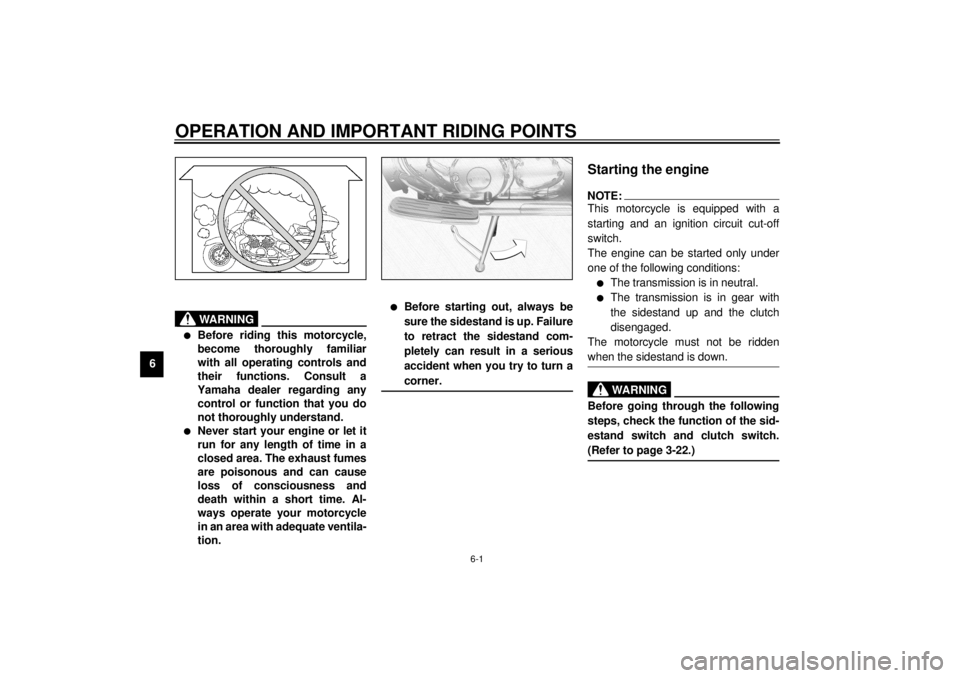
6-1
6
EAU00372
6-OPERATION AND IMPORTANT RIDING POINTS
EAU00373
WARNING
@ l
Before riding this motorcycle,
become thoroughly familiar
with all operating controls and
their functions. Consult a
Yamaha dealer regarding any
control or function that you do
not thoroughly understand.
l
Never start your engine or let it
run for any length of time in a
closed area. The exhaust fumes
are poisonous and can cause
loss of consciousness and
death within a short time. Al-
ways operate your motorcycle
in an area with adequate ventila-
tion.
l
Before starting out, always be
sure the sidestand is up. Failure
to retract the sidestand com-
pletely can result in a serious
accident when you try to turn a
corner.
@
EAU01837
Starting the engineNOTE:@ This motorcycle is equipped with a
starting and an ignition circuit cut-off
switch.
The engine can be started only under
one of the following conditions:l
The transmission is in neutral.
l
The transmission is in gear with
the sidestand up and the clutch
disengaged.
The motorcycle must not be ridden
when the sidestand is down.
@
EW000054
WARNING
@ Before going through the following
steps, check the function of the sid-
estand switch and clutch switch.
(Refer to page 3-22.) @
E_5jc_Operation.fm Page 1 Saturday, October 16, 1999 1:10 PM
Page 62 of 121
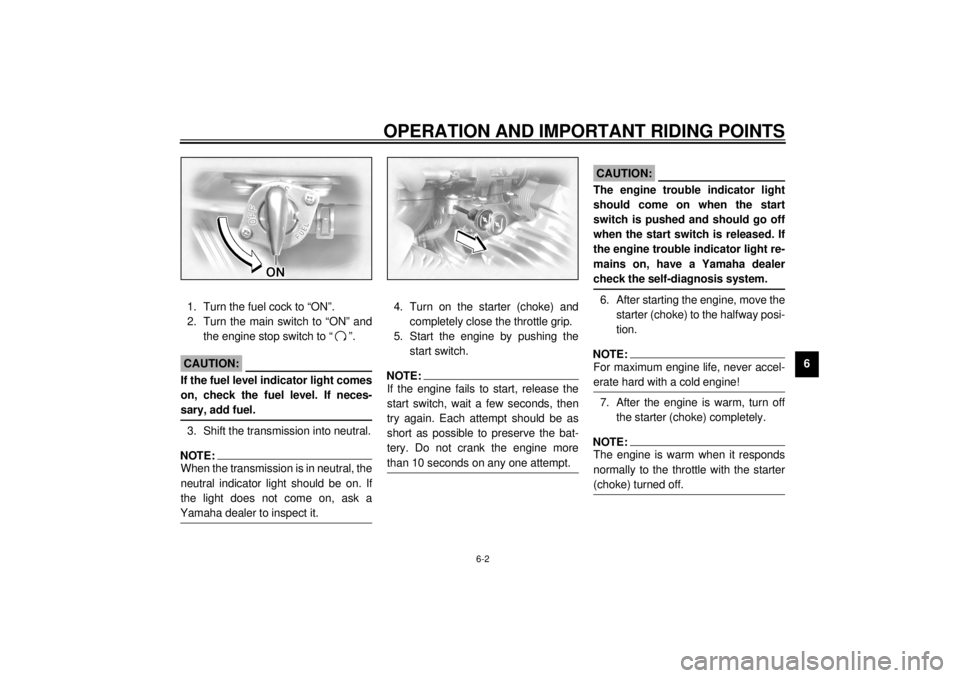
OPERATION AND IMPORTANT RIDING POINTS
6-2
6 1. Turn the fuel cock to “ON”.
2. Turn the main switch to “ON” and
the engine stop switch to “ ”.
EC000037
CAUTION:@ If the fuel level indicator light comes
on, check the fuel level. If neces-
sary, add fuel. @3. Shift the transmission into neutral.NOTE:@ When the transmission is in neutral, the
neutral indicator light should be on. If
the light does not come on, ask a
Yamaha dealer to inspect it. @
4. Turn on the starter (choke) and
completely close the throttle grip.
5. Start the engine by pushing the
start switch.NOTE:@ If the engine fails to start, release the
start switch, wait a few seconds, then
try again. Each attempt should be as
short as possible to preserve the bat-
tery. Do not crank the engine more
than 10 seconds on any one attempt. @
ECA00031
CAUTION:@ The engine trouble indicator light
should come on when the start
switch is pushed and should go off
when the start switch is released. If
the engine trouble indicator light re-
mains on, have a Yamaha dealer
check the self-diagnosis system. @6. After starting the engine, move the
starter (choke) to the halfway posi-
tion.NOTE:@ For maximum engine life, never accel-
erate hard with a cold engine! @7. After the engine is warm, turn off
the starter (choke) completely.NOTE:@ The engine is warm when it responds
normally to the throttle with the starter
(choke) turned off. @
E_5jc_Operation.fm Page 2 Saturday, October 16, 1999 1:10 PM
Page 63 of 121
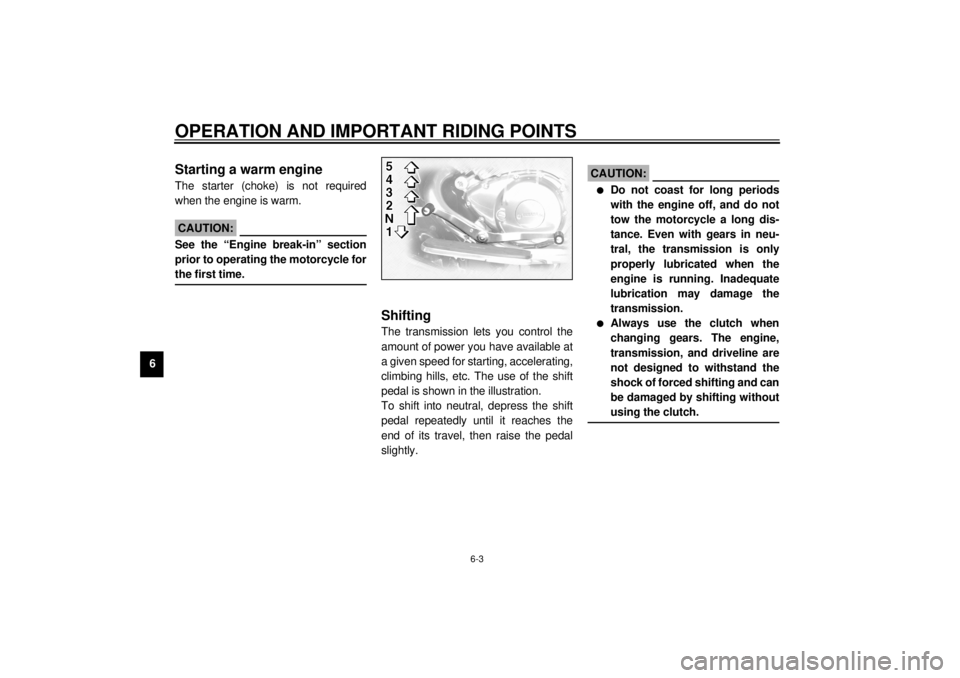
OPERATION AND IMPORTANT RIDING POINTS
6-3
6
EAU01258
Starting a warm engineThe starter (choke) is not required
when the engine is warm.
EC000046
CAUTION:@ See the “Engine break-in” section
prior to operating the motorcycle for
the first time. @
EAU00423
ShiftingThe transmission lets you control the
amount of power you have available at
a given speed for starting, accelerating,
climbing hills, etc. The use of the shift
pedal is shown in the illustration.
To shift into neutral, depress the shift
pedal repeatedly until it reaches the
end of its travel, then raise the pedal
slightly.
EC000048
CAUTION:@ l
Do not coast for long periods
with the engine off, and do not
tow the motorcycle a long dis-
tance. Even with gears in neu-
tral, the transmission is only
properly lubricated when the
engine is running. Inadequate
lubrication may damage the
transmission.
l
Always use the clutch when
changing gears. The engine,
transmission, and driveline are
not designed to withstand the
shock of forced shifting and can
be damaged by shifting without
using the clutch.
@
E_5jc_Operation.fm Page 3 Saturday, October 16, 1999 1:10 PM
Page 64 of 121
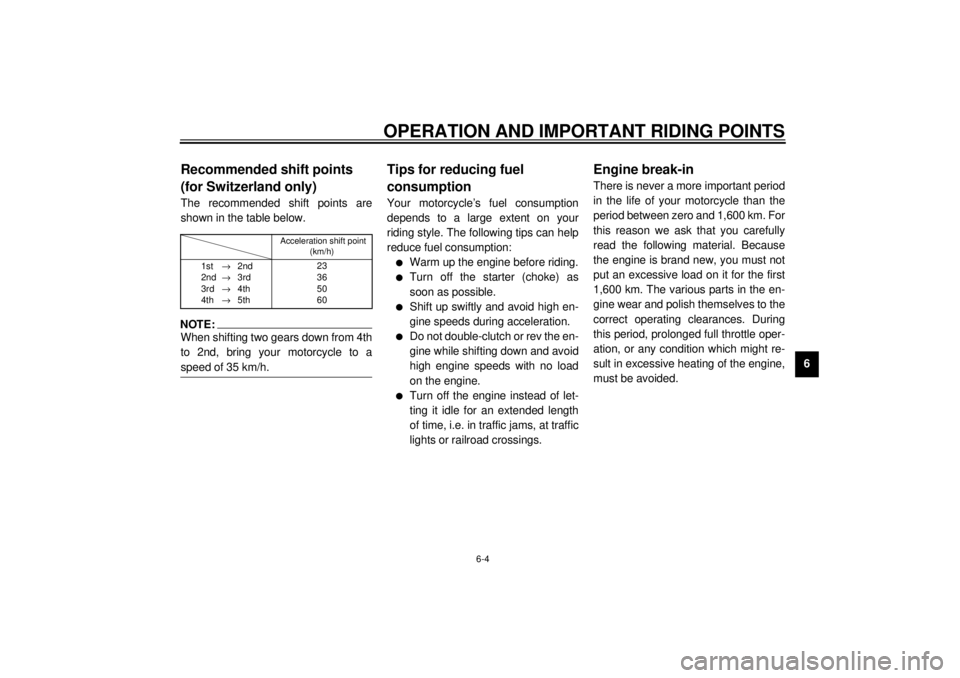
OPERATION AND IMPORTANT RIDING POINTS
6-4
6
EAU02941
Recommended shift points
(for Switzerland only)The recommended shift points are
shown in the table below.CF-25ENOTE:@ When shifting two gears down from 4th
to 2nd, bring your motorcycle to a
speed of 35 km/h. @
EAU00424
Tips for reducing fuel
consumptionYour motorcycle’s fuel consumption
depends to a large extent on your
riding style. The following tips can help
reduce fuel consumption:l
Warm up the engine before riding.
l
Turn off the starter (choke) as
soon as possible.
l
Shift up swiftly and avoid high en-
gine speeds during acceleration.
l
Do not double-clutch or rev the en-
gine while shifting down and avoid
high engine speeds with no load
on the engine.
l
Turn off the engine instead of let-
ting it idle for an extended length
of time, i.e. in traffic jams, at traffic
lights or railroad crossings.
EAU01128
Engine break-inThere is never a more important period
in the life of your motorcycle than the
period between zero and 1,600 km. For
this reason we ask that you carefully
read the following material. Because
the engine is brand new, you must not
put an excessive load on it for the first
1,600 km. The various parts in the en-
gine wear and polish themselves to the
correct operating clearances. During
this period, prolonged full throttle oper-
ation, or any condition which might re-
sult in excessive heating of the engine,
must be avoided.
Acceleration shift point
(km/h)
1st®2nd
2nd®3rd
3rd®4th
4th®5th23
36
50
60
E_5jc_Operation.fm Page 4 Saturday, October 16, 1999 1:10 PM
Page 65 of 121
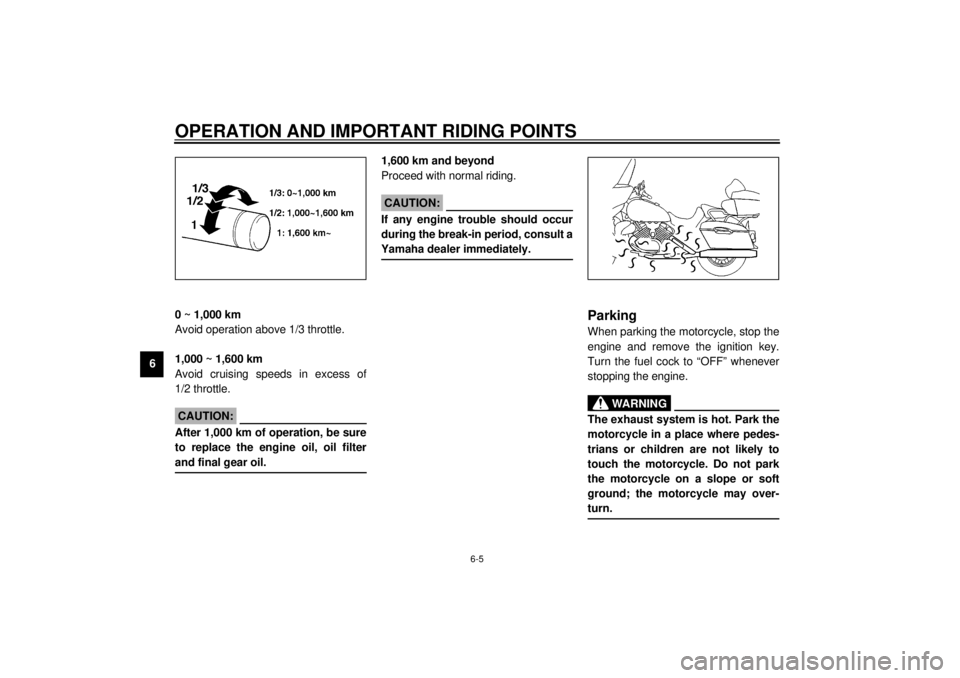
OPERATION AND IMPORTANT RIDING POINTS
6-5
6
EAU01171
0 ~ 1,000 km
Avoid operation above 1/3 throttle.
1,000 ~ 1,600 km
Avoid cruising speeds in excess of
1/2 throttle.
EC000056
CAUTION:@ After 1,000 km of operation, be sure
to replace the engine oil, oil filter
and final gear oil. @
1,600 km and beyond
Proceed with normal riding.
EC000049
CAUTION:@ If any engine trouble should occur
during the break-in period, consult a
Yamaha dealer immediately. @
EAU00457
ParkingWhen parking the motorcycle, stop the
engine and remove the ignition key.
Turn the fuel cock to “OFF” whenever
stopping the engine.
EW000058
WARNING
@ The exhaust system is hot. Park the
motorcycle in a place where pedes-
trians or children are not likely to
touch the motorcycle. Do not park
the motorcycle on a slope or soft
ground; the motorcycle may over-
turn. @
E_5jc_Operation.fm Page 5 Saturday, October 16, 1999 1:10 PM
Page 66 of 121
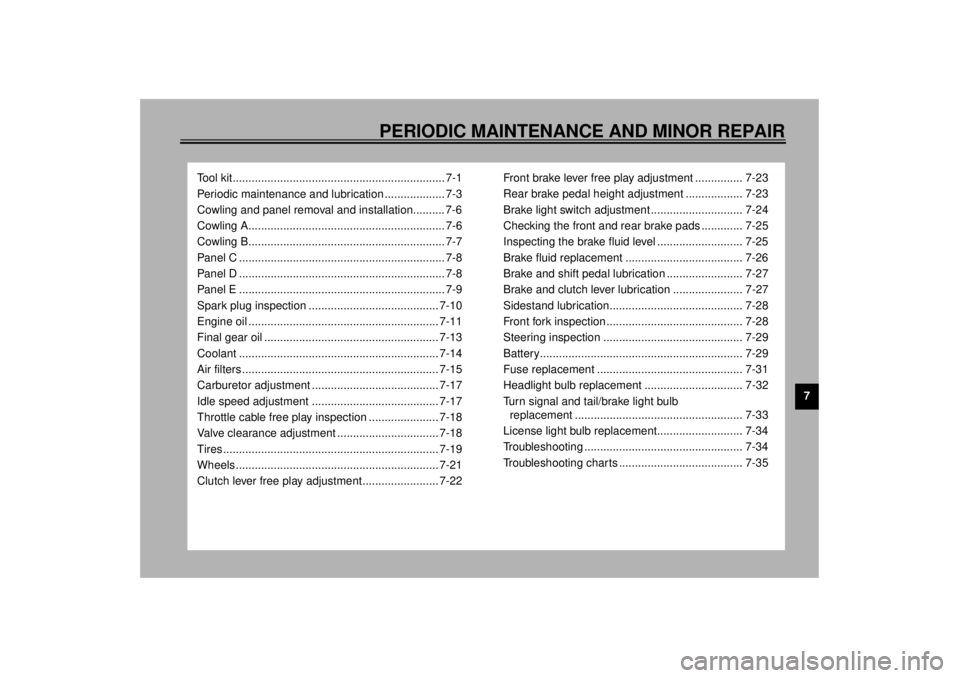
7
PERIODIC MAINTENANCE AND MINOR REPAIR
Tool kit................................................................... 7-1
Periodic maintenance and lubrication ................... 7-3
Cowling and panel removal and installation.......... 7-6
Cowling A.............................................................. 7-6
Cowling B.............................................................. 7-7
Panel C ................................................................. 7-8
Panel D ................................................................. 7-8
Panel E ................................................................. 7-9
Spark plug inspection ......................................... 7-10
Engine oil ............................................................ 7-11
Final gear oil ....................................................... 7-13
Coolant ............................................................... 7-14
Air filters .............................................................. 7-15
Carburetor adjustment ........................................ 7-17
Idle speed adjustment ........................................ 7-17
Throttle cable free play inspection ...................... 7-18
Valve clearance adjustment ................................ 7-18
Tires .................................................................... 7-19
Wheels ................................................................ 7-21
Clutch lever free play adjustment........................ 7-22Front brake lever free play adjustment ............... 7-23
Rear brake pedal height adjustment .................. 7-23
Brake light switch adjustment ............................. 7-24
Checking the front and rear brake pads ............. 7-25
Inspecting the brake fluid level ........................... 7-25
Brake fluid replacement ..................................... 7-26
Brake and shift pedal lubrication ........................ 7-27
Brake and clutch lever lubrication ...................... 7-27
Sidestand lubrication.......................................... 7-28
Front fork inspection ........................................... 7-28
Steering inspection ............................................ 7-29
Battery................................................................ 7-29
Fuse replacement .............................................. 7-31
Headlight bulb replacement ............................... 7-32
Turn signal and tail/brake light bulb
replacement ..................................................... 7-33
License light bulb replacement........................... 7-34
Troubleshooting .................................................. 7-34
Troubleshooting charts ....................................... 7-35
E_5jc_PeriodicTOC.fm Page 1 Saturday, October 16, 1999 1:10 PM
Page 67 of 121
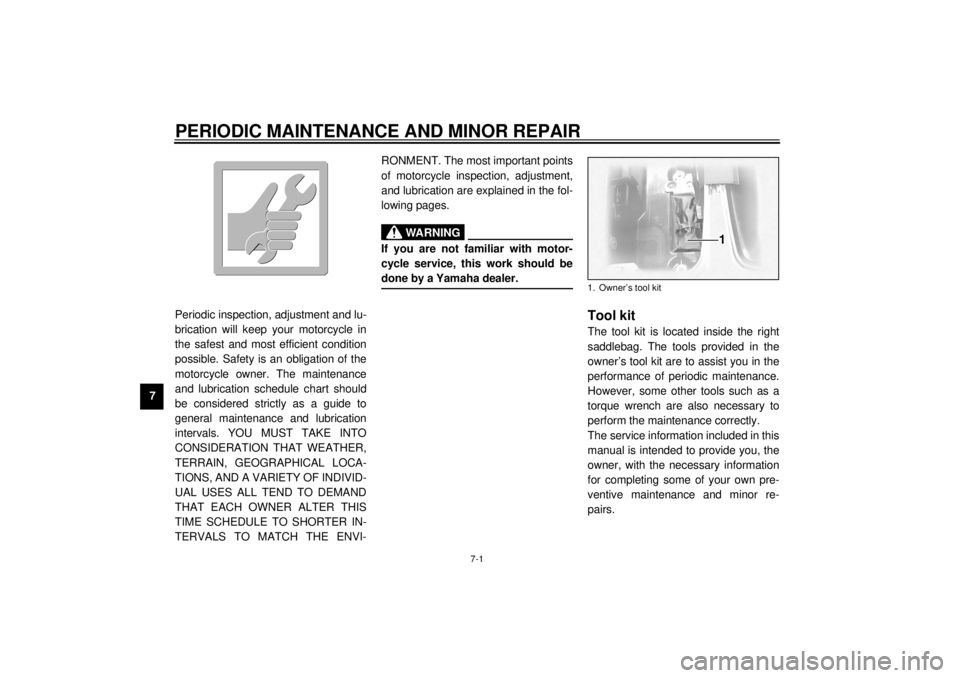
7-1
7
EAU00462
7-PERIODIC MAINTENANCE AND MINOR REPAIR
EAU00464
Periodic inspection, adjustment and lu-
brication will keep your motorcycle in
the safest and most efficient condition
possible. Safety is an obligation of the
motorcycle owner. The maintenance
and lubrication schedule chart should
be considered strictly as a guide to
general maintenance and lubrication
intervals. YOU MUST TAKE INTO
CONSIDERATION THAT WEATHER,
TERRAIN, GEOGRAPHICAL LOCA-
TIONS, AND A VARIETY OF INDIVID-
UAL USES ALL TEND TO DEMAND
THAT EACH OWNER ALTER THIS
TIME SCHEDULE TO SHORTER IN-
TERVALS TO MATCH THE ENVI-RONMENT. The most important points
of motorcycle inspection, adjustment,
and lubrication are explained in the fol-
lowing pages.
EW000060
WARNING
@ If you are not familiar with motor-
cycle service, this work should be
done by a Yamaha dealer. @
EAU01844
Tool kitThe tool kit is located inside the right
saddlebag. The tools provided in the
owner’s tool kit are to assist you in the
performance of periodic maintenance.
However, some other tools such as a
torque wrench are also necessary to
perform the maintenance correctly.
The service information included in this
manual is intended to provide you, the
owner, with the necessary information
for completing some of your own pre-
ventive maintenance and minor re-
pairs.1. Owner’s tool kit
E_5jc_Periodic.fm Page 1 Saturday, October 16, 1999 1:10 PM
Page 68 of 121
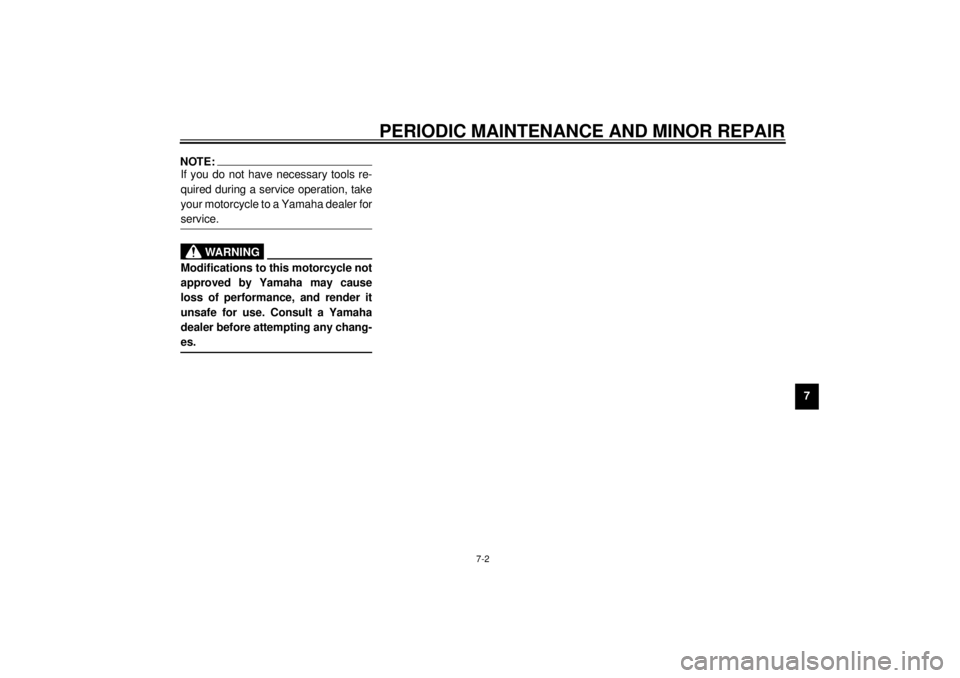
PERIODIC MAINTENANCE AND MINOR REPAIR
7-2
7
NOTE:@ If you do not have necessary tools re-
quired during a service operation, take
your motorcycle to a Yamaha dealer for
service. @
EW000063
WARNING
@ Modifications to this motorcycle not
approved by Yamaha may cause
loss of performance, and render it
unsafe for use. Consult a Yamaha
dealer before attempting any chang-
es. @
E_5jc_Periodic.fm Page 2 Saturday, October 16, 1999 1:10 PM
Page 69 of 121

PERIODIC MAINTENANCE AND MINOR REPAIR
7-3
7
EAU00473
PERIODIC MAINTENANCE AND LUBRICATION
CP-01ENO. ITEM CHECKS AND MAINTENANCE JOBSINITIAL
(1,000 km)EVERY
6,000 km
or
6 months
(whichever
comes first)12,000 km
or
12 months
(whichever
comes first)
1
*Fuel line• Check fuel hoses and vacuum hose for cracks or damage.
• Replace if necessary.ÖÖ
2*Fuel filter• Check condition.
• Replace if necessary.Ö
3 Spark plugs• Check condition.
• Clean, regap or replace if necessary.ÖÖÖ
4*Valves• Check valve clearance.
• Adjust if necessary.Every 42,000 km or 42 months
(whichever comes first)
5 Air filter• Clean or replace if necessary.ÖÖ
6*Clutch• Check operation, fluid level and vehicle for fluid leakage.
(See NOTE on page 7-5.)
• Correct accordingly. ÖÖÖ
7*Front brake• Check operation, fluid level and vehicle for fluid leakage.
(See NOTE on page 7-5.)
• Correct accordingly.
• Replace brake pads if necessary.ÖÖÖ
8*Rear brake• Check operation, fluid level and vehicle for fluid leakage.
(See NOTE on page 7-5.)
• Correct accordingly.
• Replace brake pads if necessary.ÖÖÖ
9*Wheels• Check balance, runout and for damage.
• Rebalance or replace if necessary.ÖÖ
10*Tires• Check tread depth and for damage.
• Replace if necessary.
• Check air pressure.
• Correct if necessary.ÖÖ
E_5jc_Periodic.fm Page 3 Saturday, October 16, 1999 1:10 PM
Page 70 of 121

PERIODIC MAINTENANCE AND MINOR REPAIR
7-4
7
11
*Wheel bearings• Check bearing for looseness or damage.
• Replace if necessary. ÖÖ
12*Swingarm• Check swingarm pivoting point for play.
• Correct if necessary.
• Lubricate with molybdenum disulfide grease every 24,000 km or
24 months (whichever comes first).ÖÖ
13*Steering bearings• Check bearing play and steering for roughness.
• Correct accordingly.
• Lubricate with lithium soap base grease every 24,000 km
or 24 months (whichever comes first).ÖÖ
14*Chassis fasteners• Make sure that all nuts, bolts and screws are properly tightened.
• Tighten if necessary.ÖÖ
15 Sidestand• Check operation.
• Lubricate and repair if necessary.ÖÖ
16*Sidestand switch• Check operation.
• Replace if necessary.ÖÖÖ
17*Front fork• Check operation and for oil leakage.
• Correct accordingly.ÖÖ
18*Rear shock absorber
assembly• Check operation and shock absorber for oil leakage.
• Replace shock absorber assembly if necessary. ÖÖ
19*Rear suspension relay
arm and connecting arm
pivoting points• Check operation.
• Lubricate with molybdenum disulfide grease every 24,000 km or
24 months (whichever comes first).ÖÖ
20*Carburetors• Check engine idling speed, synchronization and starter operation.
• Adjust if necessary.ÖÖÖ
21 Engine oil• Check oil level and vehicle for oil leakage.
• Correct if necessary.
• Change. (Warm engine before draining.)ÖÖÖ
22 Engine oil filter cartridge• Replace.ÖÖ NO. ITEM CHECKS AND MAINTENANCE JOBSINITIAL
(1,000 km)EVERY
6,000 km
or
6 months
(whichever
comes first)12,000 km
or
12 months
(whichever
comes first)
E_5jc_Periodic.fm Page 4 Saturday, October 16, 1999 1:10 PM